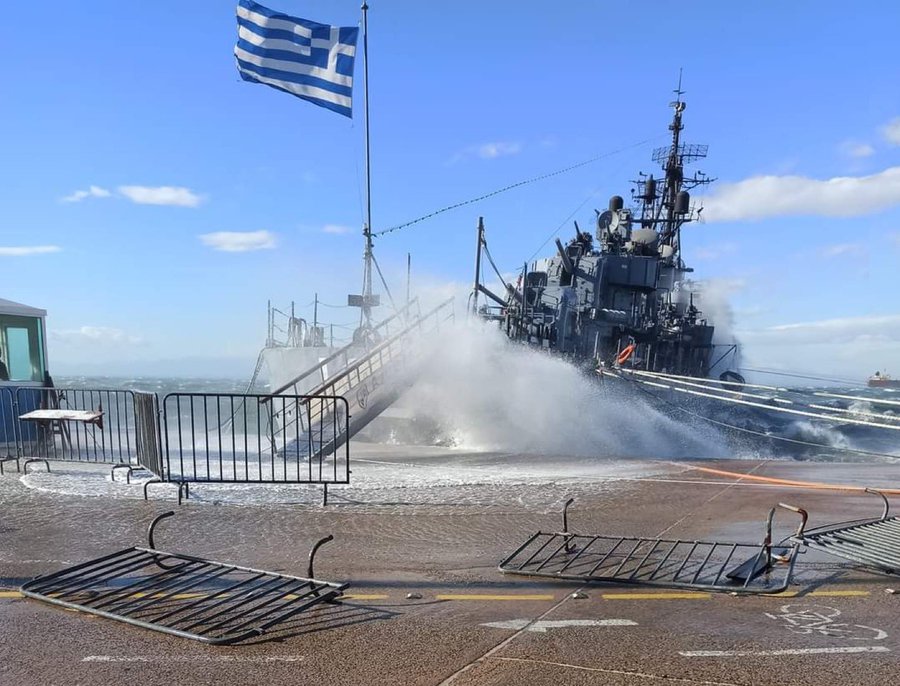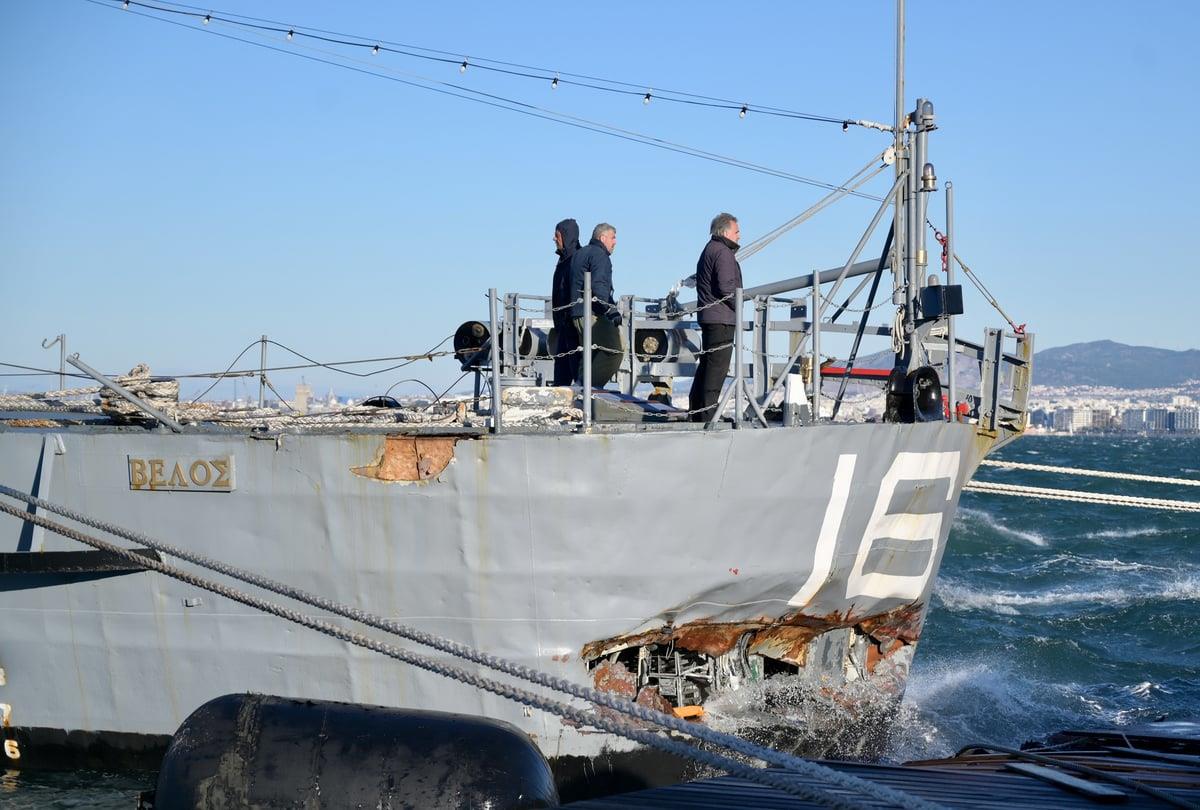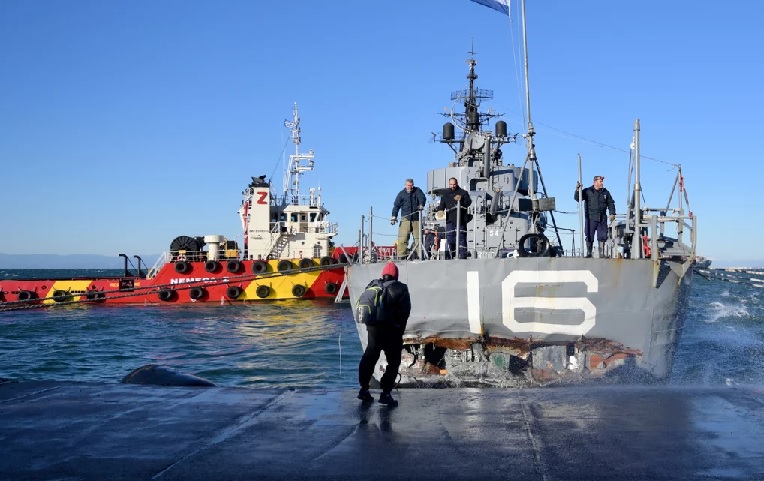The historic Hellenic Navy destroyer “Velos”, which now operates as a floating museum and had been docked at the waterfront in Thessaloniki since 2019, has been extensively damaged and faced the risk of sinking due to gale force winds and very rough sea.
The symbol for anti-dictatorship struggle AT Velos operates as a floating museum and has been docked at Nea Paralia waterfront in Thessaloniki since 2019.

The destroyer sustained heavy damage to its stern on Saturday and has been at risk of sinking due to successive impact on the wharf by the powerful winds that kept slamming its stern to the dock.

Αn operation was launched on Sunday morning to seal a breach in the stern of “Velos” and drain water, while a diver had to determine the extent of the damage and a tugboat was helping the damaged vessel to stay in place.

The Velos was ultimately towed to the facilities of the Thessaloniki Port Authority.

A new inspection by divers is expected to be carried out on Monday, in order to assess the full extent of the damage and to decide where it will be moved so that repair work can be carried out.
The cost of repair is expected to be borne by a Greek shipping company, which in also covers its maintenance costs, local media reported.

The ship had been similarly damaged, though not enough so as to affect its stability and durability, during bad weather in March.
While there are thoughts to return the VELOS to its original base, the Naval Tradition Park in Palaio Faliro, south Athens, the Master Chief of Velos, Panagiotis Kallinos, told media, that they have been asking for the relocation of Velos since quite some time.
Over 200,000 visitors have visited “Velos” in four years, since 2019.
Built in Boston, USA and launched on June 3, 1942 as the USS “Charrette” DD 581, it served in the Hellenic Navy for 32 years. It was given to the then Greek Royal Navy in 1958 and withdrawn from active duty in 1991, while it was designated a Museum of Antidictatorial Struggle in 1994.
Mutiny of VELOS
On 25 May 1973, Velos, under the command of Nikolaos Pappas, while participating in a NATO exercise and in order to protest against the dictatorship in Greece, anchored at Fiumicino, Italy, and refused to return to Greece.
When in patrol with other NATO vessels between Italy and Sardinia at midday on 25 May 1973 the captain and the officers had learned by radio that naval officers had been arrested and tortured in Greece. Commander Pappas was in a group of democratic officers who were loyal to their oath to obey the Constitution and planned to act against the junta. Pappas knew the arrested officers opposed the junta and realised there was no further hope for a movement inside Greece. He decided to act alone to motivate global public opinion.
Pappas mustered the crew on the stern and announced his decision, which was received with enthusiasm. Pappas signaled his intentions to the commander of the squadron and NATO Headquarters, quoting the preamble of the North Atlantic Treaty (founding treaty for NATO) which declares that “all governments … are determined to safeguard the freedom, common heritage and civilization of their peoples, founded on the principles of democracy, individual liberty and the rule of law”. Leaving formation, he sailed for Rome.
That afternoon, he anchored about 3.5 nautical miles (6.5 km) off the coast at Fiumicino and three officers (Ensigns K. Gortzis, K. Matarangas, G. Stratos) went ashore in a whaleboat. From Fiumicino Airport they telephoned the international press agencies to inform them of the situation in Greece and the presence of the destroyer. They arranged for a press conference to be held the next day by Commander Pappas. This action sparked international interest in the situation in Greece. The captain, six officers and twenty-five petty officers requested asylum and remained in Italy as political refugees.
Initially, the entire crew wished to follow their captain (170 men signed a request), but they were advised (and some ordered) by their officers to remain on board because of the fear of retaliation by the regime against their families.
The men were told to return to Greece and to inform their families and friends about what had happened. Velos returned to Greece a month later with a replacement crew.
After the fall of the junta on (24 July 1974), some of the officers returned to the navy. Commander Pappas reached the rank of Vice admiral and served as the chief of the Hellenic Navy General Staff from 1982 to 1986.
Velos was decommissioned on 26 February 1991, having sailed 362,622 nautical miles (671,576 km; 417,298 mi) in her 48-year career. (via wikipedia)
PS I guess an “internal investigation” in the Navy will be launched to determine what went wrong and the destroyer was destroyed, when all weather forecasts predicted 8-9 Beaufort with gusts of 10 B.
